![]()
![]()
![]()
Use LEFT and RIGHT arrow keys to navigate between flashcards;
Use UP and DOWN arrow keys to flip the card;
H to show hint;
A reads text to speech;
11 Cards in this Set
- Front
- Back
- 3rd side (hint)
|
Antagonists |
Muscle that reverses, or opposes, the action of another muscle. |
|
|
|
FLEX HEAD |
Sternocleidomastoid |
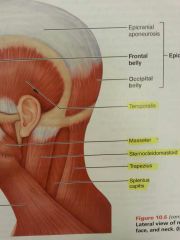
Lateral, close to ear |
|
|
Extend Head |
1.) Tapezius
2.) Splenius Capitus |

|
|
|
Elevate Ribs |
External Intercostals
Description: 11 pairs lie between ribs; fibers run obliquely (down and forward) from each rib to rib below; in lower intercostal spaces, fibers are continuous with external oblique muscles, forming part of abdominal wall
. Intercostal nerves |
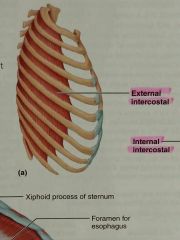
Ribs |
|
|
Depress Ribs |
Internal Intercostals |
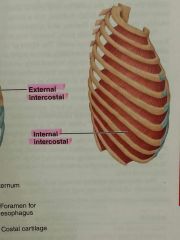
|
|
|
Adduct Thigh |
1.) Adductors - Adductor Magnus = Anterior.
Description: Adducts and medially rotates and flexes thigh; posterior part is a synergistic of hamstrings in thigh extension - Adductor Longus - Adductor Brevis = Adducts, flexes, and medially rotates thigh
2.) Gracilis - Addicts thigh, flexes and medically rotates leg (especially during walking) |
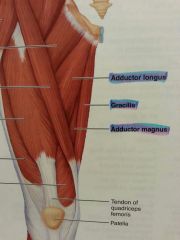
Adductors: Large muscle masses consisting of 3 muscles M, L, & B
Gracilis: Long, thin, superficial muscle of medial thigh |
|
|
Abduct Thigh |
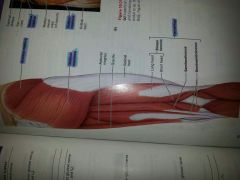
Gluteus Medius Description: Thick muscle largely covered by gluteus maximum.
Action: Abducts and medially rotates thigh.
|
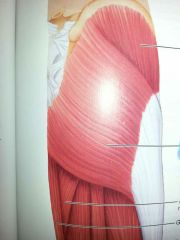
|
|
|
Flex arm |
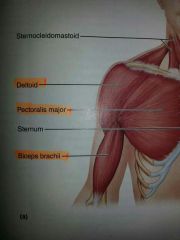
1.) Pectoralis Major Description: Large fan shaped muscle covering superior portion of chest
Action: Adducts and mediately rotates arm
2.) Deltoid Description: Thick, multipennate muscle forming rounded shoulder muscle mass.
Action: Prime mover of arm abduction when all its fibers contract simultaneously.
3.) Biceps Brachii Description: Two headed uniform muscle (anterior muscle)
Action: Flexes and supinates forearm |
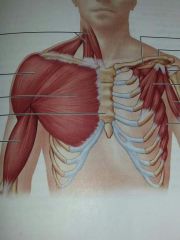
|
|
|
Extend arm |
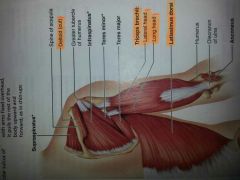
1.) Latissimus Dorsi Description: Broad, flat, triangular muscle of lower back (lumbar region)
Action: Prime mover of arm extentions; powerful arm adductor; medially rotates arm at shoulder
2.) Deltoid Description: Thick, multipennate muscle forming rounded shoulder muscle mass.
Action: Prime mover of arm abduction when all its fibers contract simultaneously.
3.) Triceps Brachii Description: Large fleshy muscle; the only muscle of posterior compartment of arm; three headed origin.
Action: Powerful forearm extensor |
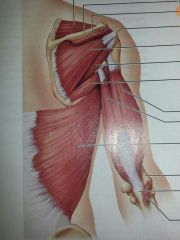
|
|
|
Flex Trunk |
1.) Rectus Abdominis Description: Medial superficial muscle pair; extend from pub is to rib cage; endeared by aponeuroses of lateral muscle; segmented by three tendinous intersections Action: Flex and rotate lumbar region of vertebral column 2.) Iliopsoas Description: Is a composite of two closely related muscles (locus and psoas major) whose fibers pass under the inguinal ligament to insert via a common tendon on the femur . A.) Iliacus Description: Large, fan shape, more lateral muscle Action: Prime mover for flexing thigh, or for flexing trunk on thigh (as during a bow) B.) Psoas Major Description: Longer, thicker, more medial muscle of the pair. Action: As above, also flexes vertebral column laterally (important postural muscle) |
|
|
|
Extend trunk |
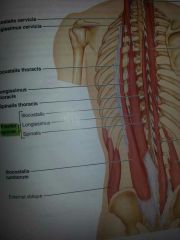
Elector spinae Description: Prime mover - consist of three columns. Provides resistance that helps control action of bending forward at the waist and act ad powerful extensions to promote return to erect position. A.) Illocostalis Description: Most lateral muscle group of erector spine muscles (extend from pelvis to neck) Action: Extwnd and laterally flex the vertebral column. B.) Longissimus Description: Intermediate tripartite muscle group of rector spinae; extend by many muscle slips from lumbar region to skull (mainly pass between transverse processes of vertebrae). Action: extend and laterally flexes vertebral column; captions extends head and turns the face toward same side. C.) Spinails Description: Composite muscle forming part of deep layer of intrinsic back muscles extends from the thorasic region to head Action: Extends vertebral column |
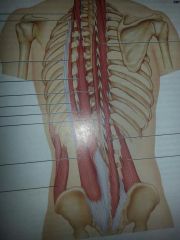
|

